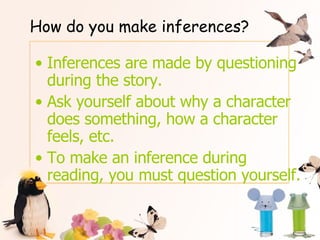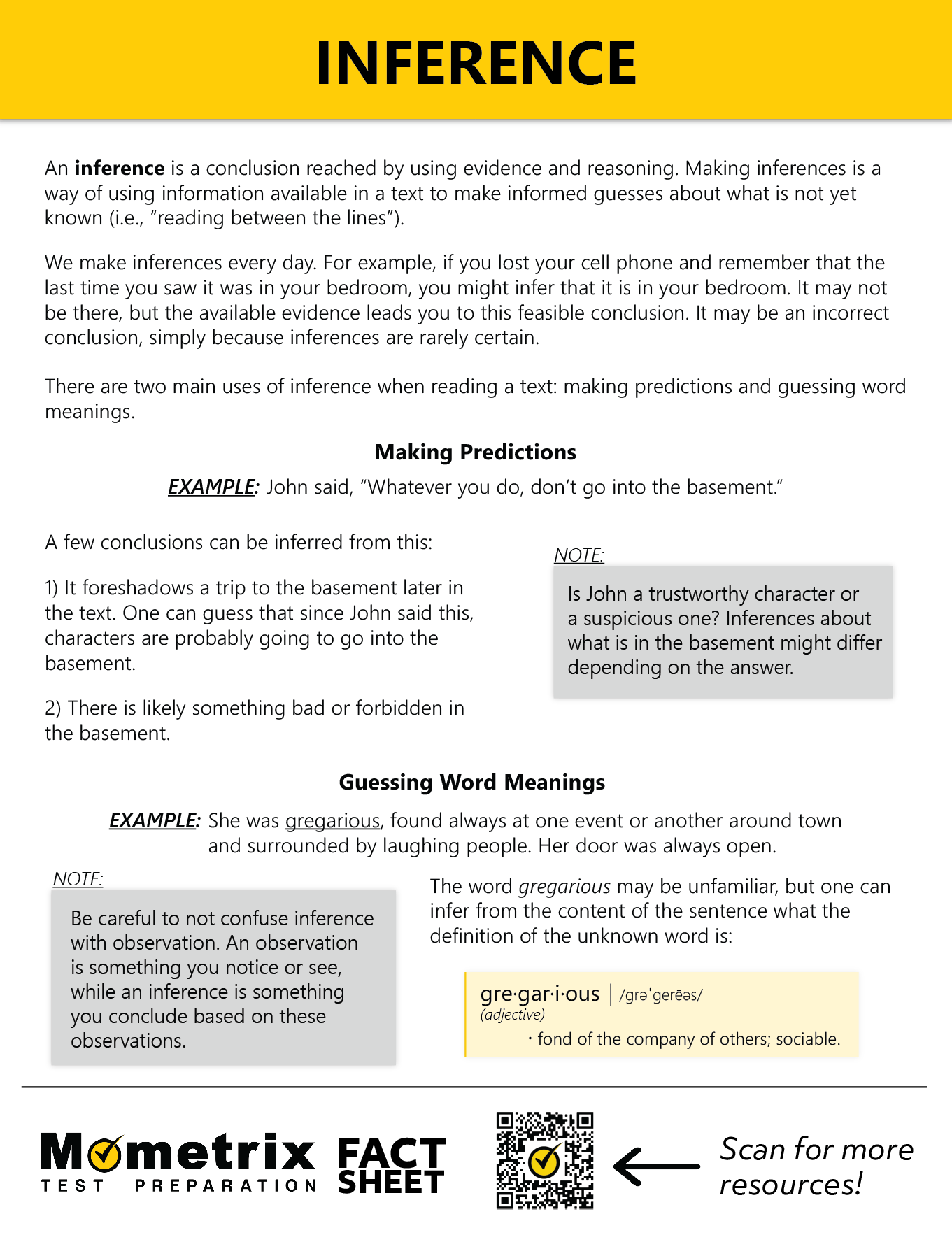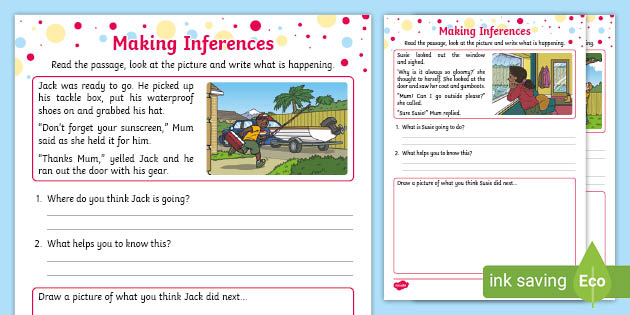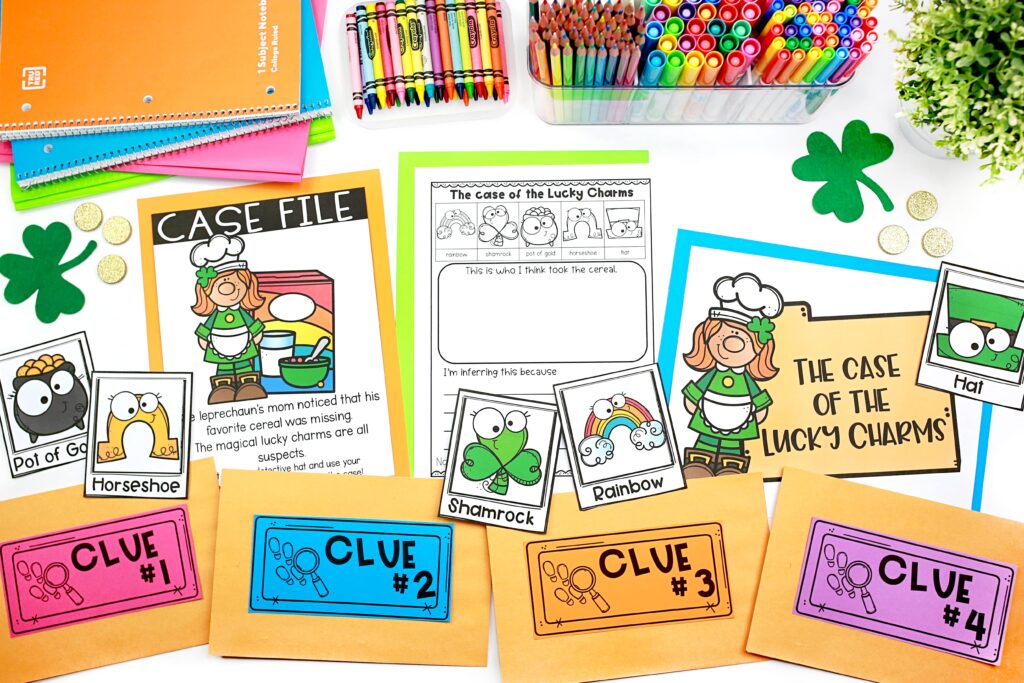40 how do you make an inference
Follow 5 Steps to Make an Inference - Reading Inferences are made by putting multiple clues together. Group the following details: jumping up and down, moving around, and rubbing and huffing on their hands. Using background knowledge, predict what the combination of actions might indicate-the kids are trying to generate some heat or keep warm. Inference Skills, and Inferring: A Complete Guide for ... Inference can be defined as the process of drawing of a conclusion based on the available evidence plus previous knowledge and experience. In teacher-speak, inference questions are the types of questions that involve reading between the lines. Students are required to make an educated guess, as the answer will not be stated explicitly.
Inference: Confidence Intervals - ENV710 Statistics Review ... In statistical inference, we take what we know from the sample, apply the underlying theory of sampling (central limit theorem) to make statements about our population of interest. We make estimates about the population through the use of the sample data. Estimates can either be point estimates or interval estimates.

How do you make an inference
Making Inferences: How To Build This Critical Thinking ... Use these steps to help you make an inference: 1. Identify the premise When making an inference, first identify what you are inferring. This allows you to focus on what you are trying to understand. For example, if you see your brother carrying a baseball, you may want to make an inference of what your brother is doing. 2. Ask a question How do you make an inference? - Answers An inference is an educated guess based on given knowledge. For example, if you're reading a story and the setting is rainy, then you can make an inference that the sky is gray and cloudy. How do you make an inference question ... Making inferences means to draw conclusions or to make judgments based on facts. Write the important details and facts in the boxes on the left. This chart could be used to infer about story characters or plot. It could also be used to infer from observations in nature or historical events. What does inference mean in reading?
How do you make an inference. Making Inferences | Developmental Reading To make inferences from reading, take two or more details from the reading and see if you can draw a conclusion. Remember, making an inference is not just making a wild guess. Making Inferences to Improve Reading Comprehension Making inferences requires students to combine what they are reading with what they already know, to reach into their own personal knowledge and apply it to what they are reading. In the previous example, a student needs to know that having a bathing suit means someone is going swimming and that getting seasick means someone is going on a boat. PDF Effective Teaching of Inference Skills for Reading This class of inferences includes: 1. coherence inferences (described above). 2. "case structure role assignments", e.g.Dan stood his bike against the tree. The reader needs to realise that the tree is assigned to a location role. 3. some "antecedent causal" inferences, e.g. He rushed off, leaving his bike unchained. Making inferences from random samples (practice) | Khan ... If you're seeing this message, it means we're having trouble loading external resources on our website. If you're behind a web filter, please make sure that the domains *.kastatic.org and *.kasandbox.org are unblocked.
What is Inference? - How to Infer Intended Meaning - Video ... How to Practice Making Inferences When reading, we make inferences through the author, the text and our response. The first step to reaching a conclusion of the intended meaning of a writing is to... How do you make statistical inferences from data? | by ... First, we need to come up with an ideal sample size for each group. Using the following code we calculate the sample size for both the groups. For a 95% confidence interval and 5% margin error, we calculate the ideal sample size for Group A (males) is 242, and for Group B (females) is 251. 42 how do you make an inference - Best Place For Kids Learning How do you make an inference question ... Making inferences means to draw conclusions or to make judgments based on facts. Write the important details and facts in the boxes on the left. This chart could be used to infer about story characters or plot. It could also be used to infer from observations in nature or historical events. Inference Examples - Softschools.com When we make an inference, we draw a conclusion based on the evidence that we have available.When we make inferences while reading, we are using the evidence that is available in the text to draw a logical conclusion. The writer or speaker does not come out and state the answer to the question that we are asking of the text-rather, we have to use the evidence that is there to make an informed ...
Making inferences in literary texts | Reading | Khan ... What does it look like to make inferences from a story? Sherlock Bones, the legendary dogtective, will show us!Khan Academy is a nonprofit organization with ... How to Make an Inference in 5 Easy Steps - ThoughtCo Most of the time, you'll get questions asking you to find the main idea, determine the author's purpose, understand vocabulary in context, figure out the author's tone, and, the topic at hand, make inferences. Inferences | Reading Comprehension Exercise - TeacherVision Making an inference involves using what you know to make a guess about what you don't know or reading between the lines. Readers who make inferences use the clues in the text along with their own experiences to help them figure out what is not directly said, making the text personal and memorable. Inference | Classroom Strategies | Reading Rockets Often, inferring is introduced to students by using familiar symbols, activities, and environments from which they automatically draw inferences or make predictions (an inference about the future). For example, suppose you are about to begin a unit on the Great Depression.
Inference - Definition, Meaning & Synonyms | Vocabulary.com When you make an inference, you're reading between the lines or just looking carefully at the facts and coming to conclusions. You can also make faulty inferences. If you hear a person's weight is 250 pounds, you might make the inference that they're overweight. But what if they're seven feet tall? Definitions of inference noun
How do you make an inference in science? An inference is an interpretation or an explanation of an observation. The observation is made using our senses. To make an inference, we connect what we observe to prior knowledge and the new information observed through our senses. An inference can be made from more than one observation, and it is not just a guess. Read full answer here.
A Simple Way to Teach Students to Make Meaningful Inferences After we go over this secret formula, we go over the following simple steps that readers do when making inferences: Ask What You Already Know: Ask yourself what you already know about what you are reading that can help you to make an inference. Ask "Thick" Why Questions: Ask thick questions as you read to make inferences about what is happening ...
Examples of Inference - YOURDICTIONARY When you are reading, you can make inferences based on information the author provides. The literary definition of "inference" is more specifically: "Using clues provided by the author to figure things out." You might use these context clues to figure out things about the characters, setting, or plot.
Learn how to make inferences - YouTube Learn how to make inferences in literature, nonfiction and real life, and to support those inferences with strong, reliable evidence.An inference is just com...
When & How to Use Inferences | LiteraryTerms.net When to Use Inferences. In formal essays, you're using inferences whether you mean to or not. Since inference is the basic building block of arguments, any argumentative essay contains countless inferences. The real question is how good the inferences are. In literature, you use inferences as a reader all the time.
PDF Draw Conclusions and Make Inferences Make an inference about what you think might be happening. Drawing Conclusions and Making Inferences . Imagine another main chara˚er is going to be introduced to the text you are reading. Make an inference about who the new chara˚er will be. Create a chara˚er profile for them.
Make Inferences from Samples (with videos, worksheets ... Make Inferences from Samples Video lessons with examples and solutions to help Grade 7 students understand that statistics can be used to gain information about a population by examining a sample of the population; generalizations about a population from a sample are valid only if the sample is representative of that population.
PDF Making Inferences using pictures and video clips Today you will make inferences from pictures and video clips by using observation, evidence, and reasoning. Today you will be able to distinguish the difference between making a prediction and making an inference. Today you will explain why this skill is an important strategy for the improvement of reading comprehension.
Teaching Strategy: Learning to Infer | Facing History Model How You Infer by Using an Example from the Specific Text You Are Using Read or write up some information on the board from the text or related to a character. Next, write up the relevant background knowledge you have. Third, show students how you put the two together to make an inference or interpretation. Inferencing Frameworks
How do you make an inference question ... Making inferences means to draw conclusions or to make judgments based on facts. Write the important details and facts in the boxes on the left. This chart could be used to infer about story characters or plot. It could also be used to infer from observations in nature or historical events. What does inference mean in reading?
How do you make an inference? - Answers An inference is an educated guess based on given knowledge. For example, if you're reading a story and the setting is rainy, then you can make an inference that the sky is gray and cloudy.
Making Inferences: How To Build This Critical Thinking ... Use these steps to help you make an inference: 1. Identify the premise When making an inference, first identify what you are inferring. This allows you to focus on what you are trying to understand. For example, if you see your brother carrying a baseball, you may want to make an inference of what your brother is doing. 2. Ask a question

































0 Response to "40 how do you make an inference"
Post a Comment